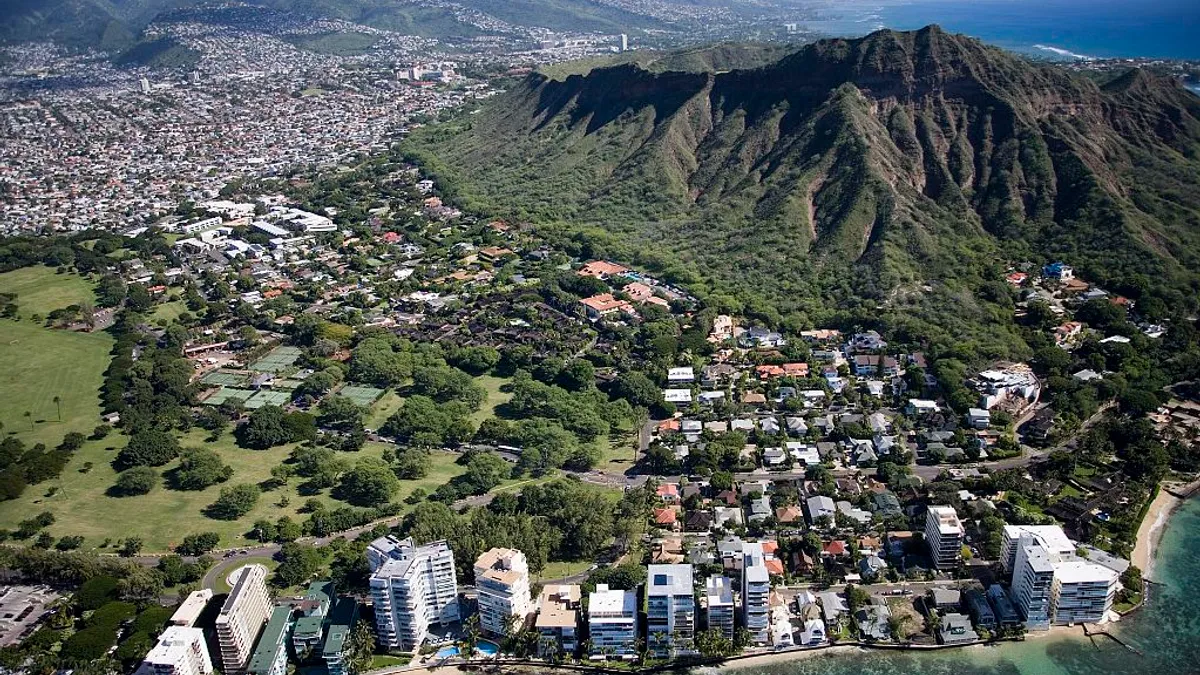Dive Brief:
-
Regulators at the Hawaii Public Utilities Commission (PUC) on Tuesday grilled Hawaiian Electric (HECO) representatives on their plans to replace a 180 MW coal plant on Oahu, amid concerns that without adequate planning the facility will be replaced with oil-fired generation after it is retired in 2022.
- The AES coal plant serves around 15% of demand on Oahu and is one of the fossil fuel plants that HECO is looking to shutter in the next couple of years. But regulators worry that delays to renewables projects that are planned to help replace the plant could require the state to turn to oil at the end of the next year.
-
"Your plan to me amounts to a shift from one fossil fuel to another. We're going from cigarettes to crack," James Griffin, chair of the Hawaii PUC, told utility representatives during a status conference on Tuesday.
Dive Insight:
Apart from retiring the Oahu coal plant by the end of 2022, HECO also plans to close down the 38 MW oil-fired Kahului plant by 2024, as well as retire two units of an oil plant in Waiau as soon as it can. A critical component of the utility's plans to retire these facilities is a series of utility-scale solar and storage projects, including the proposed 135 MW Kapolei energy storage facility, which is slated to come online in summer 2022.
But stakeholders have been raising concerns over the last several months that HECO's interconnection processes are unnecessarily delaying projects and making them more expensive. In February, the commission opened a docket to take a closer look at the development of these projects and the broader plan to retire the Oahu plant, noting that delays could pose a threat to the island's grid reliability. HECO, meanwhile, has maintained that it isn't solely responsible for the delays, noting that developers also need to move quickly and avoid last-minute changes to project plans.
At the status conference on Tuesday, regulators voiced alarm over the possible repercussions for reliability and Hawaii's transition to clean energy resources. At the time that the AES plant is retired, the utility anticipates having 12.5 MW of solar-plus-storage online, as well as the Kapolei storage project. But because the Kapolei facility would come online before most of the other renewables projects, its primary source of charging will initially be from fossil fuel generation.
"Your linchpin of this transition would be what appears on paper to me the most expensive generating resource on this island that we've ever built, fueled by oil," Griffin said, adding, "you want us to rubber-stamp the most expensive oil-fired peaking generation unit, which you know we would never approve if it was a dispatchable generator, but that's what this is in effect."
Another concern for regulators is that possible increases in oil prices could also push up ratepayer bills after the Oahu plant is retired.
"It's a significant impact, the delays of these [renewables] projects. Those projects were going to smooth the transition," Griffin said.
From a reliability perspective, regulators worry that the utility is putting all its eggs in one basket — a risky prospect given that it hasn't operated batteries of this scale before, don't know when they'll come online or even how they'll move though the regulatory process, Commissioner Jennifer Potter noted.
"There [are] problems with the planning that's happening at this utility," she added.
HECO, however, pushed back during the status conference. The utility's reserves going into the fall of 2022 will be tight, Colton Ching, senior vice president of planning and technology, acknowledged — but with the approval of the projects proposed to the commission, including the Kapolei project, "we will be okay," he said.
Part of the issue is that the utility wants to make sure that its planned resources will work as intended.
"We have one shot of getting the resources to work and operate the way we need and if they don't — if the wrong equipment is procured, if the wrong design is used — then we won't be able to use these resources in the way that we like to, i.e. to run them in a way where we don't have to rely on as many fossil generators," Ching said.
And while HECO will take ownership for delays that it caused, it also had to wait on receiving information and modeling in some cases, Ching said.
A big risk area is the permitting process, which presents a lot of uncertainties for developers, he added.
"We see this as something perhaps that we can help with, to work with the developers, work with agencies… to get permits reviewed more quickly," Ching said.















